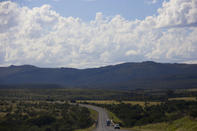Centre for Farmlands
The surrounding region of where modern-day Queenstown lies was once inhabited by the San and Bushmen. After European settlement in the early 1800s, the area became farmlands for both Boer settlers and European farmers. In 1953, Queenstown was laid out and designed as a military outpost by the British.

It was meant to protect British subjects against any attacks during the Frontier Wars, which involved clashes between the British and the Xhosa tribe over territory. The town was planned around a central hexagon, which would be the point to where citizens could flee if there were signs of trouble. Although it is still a distinguished feature of the town, it was never used for its original purpose.
Queenstown grew into a service town for farmers from the area. The early settlement was known for its wagon building, imported merchandise and educational institutions. In the late 19th Century, sandstone buildings were erected, including the Town Hall, the Methodist Church, the Anglican Church and the Dutch Reformed Church.
In the 1920s the town flourished as the prime educational centre for the area, specifically Queen’s College. In 1984, the local rural settlement Mlungisi was incorporated into Queenstown, from where many of South Africa’s political thinkers emerged. Today the town is a charming mix of heritage, farming services, education and gardens of roses. It is also a popular stopover for travellers on their way to the Central Karoo.